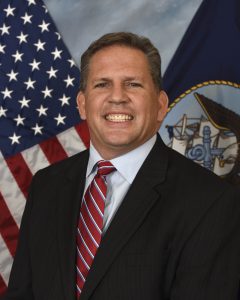
WASHINGTON, D.C. – The Defense Department has about two years to make some “fundamental changes” in acquisition to match the new National Defense Strategy, and buying the same things in the same way will not be acceptable, the Navy’s top acquisition official said on Wednesday.
“We in the acquisition community, that’s all of us, we actually have to deliver. It’s not about the processes, it’s output. We actually have to deliver lethal capacity to the force,” James Geurts, the Assistant Navy Secretary for Research, Development and Acquisition told the Wednesday audience at the Defense Daily forum on Modular Open Systems.
“From a Navy perspective, the big challenge is, how do we build a Navy that can compete and win,” he said.
“If you look at the future fight, you might quickly surmise the Navy and the Marine Corps, in particular, are going to have a leading role in that.”
“That’s going to be a challenging fight,” with the threats in the Pacific, and the Marine Corps commandant talking about having to fight to get to the fight, Geurts said. “You hear us talk about do we have enough force structure, the right force structure, the right capabilities on that force structure?”
“If the only way we’re going to do it is just to buy more of what we always bought, in the way we always bought it… I know we’re not going to get there.”
“Maybe in the last 10 to 15 years, we could afford to be risk-averse, to be very methodical. I don’t believe we have that luxury anymore.”

Geurts challenged the audience, mainly comprised of defense industry representatives, to help the department decide, “in a relatively short amount of time, how are we going to effectively change the trajectory to continue to put us on a path to compete and win as a nation.”
The idea of open systems architecture and open standards that allow improvements in the capability of platforms and systems quickly without major structural changes “is one of the ways we can fundamentally change the direction,” he said.
Geurts said he thinks of naval power as a combination of three factors: “Capacity, how much stuff do you have; capability, how capable is the stuff you have, and availability, how available is it… We could build a lot of ships but if they’re not available, it’s not going to do us any good. If 50 percent of our airplanes are sitting on the ramp, broken, that’s no good. We have to make sure we are attacking availability.”
The secretary, who came to the Navy job after working acquisition for the Special Operations Command, which he said is very quick in pivoting to meet new situations, said he has pushed decentralization of acquisition authority down to the program manager level to speed up decisions and was trying to increase digitization of the process.
Open standards and giving the government more control over the software and details of new systems, “will drive affordability… and allow competition at multiple levels,” he said.
Geurts said he also was concerned about the shrinking size of the defense industry workforce and the fact that 50 percent of shipbuilding workers have less than five years of experience.
Geurts said he was “a velocity guy. It’s all about speed,” but moving “in the right direction, not off the cliff. We’ve lost a lot of our speed, as a nation. We need to get it back.”
“No one can accurately predict the future. I just don’t want to be really wrong.”
A member of the audience complained that the problem with acquisition was that the amount of money devoted to defense has declined.
But Geurts said when the Defense Department has $600 billion, the idea that it does not have enough money, “hurts my head.”
“It’s not a case of not enough money,” he said, but the high sustainment cost for weapons, because they spend a lot of time deciding requirements for new systems but little time thinking about how to reduce the cost to support them.




